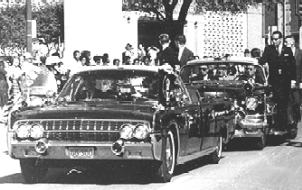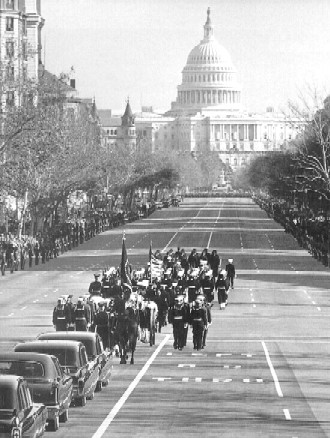President Kennedy Assassinated
 I was standing in line at a drinking fountain when a fellow 7th grader, Arthur Christ, told me that Kennedy had been shot in Dallas. We all returned to our classrooms and the principal made an official announcement over the speaker system. We students were sent home early. I wasn't touched emotionally by his death. I was young and supported Nixon anyway. I watched the news and funeral on TV. ~ Our family had just purchased an LP comedy album called "the First Family". We stopped playing it and bought a memorial LP for John F. Kennedy. I was standing in line at a drinking fountain when a fellow 7th grader, Arthur Christ, told me that Kennedy had been shot in Dallas. We all returned to our classrooms and the principal made an official announcement over the speaker system. We students were sent home early. I wasn't touched emotionally by his death. I was young and supported Nixon anyway. I watched the news and funeral on TV. ~ Our family had just purchased an LP comedy album called "the First Family". We stopped playing it and bought a memorial LP for John F. Kennedy. Listen to the late breaking news of Kennedy's death. |
The reaction of the Secret Service Agents was quite slow. Most of them had spent the evening before in "The Cellar" bar that was owned by an aquaintance of Jack Ruby. 45 minutes later, Lee Harvey Oswald was arrested on charge of murdering police officer J.D. Tippit. After hours of interrogation where he had no lawyer and standard police procedure was violated, Oswald was accused of murdering John F. Kennedy. On November 24, 1963, a Sunday morning, the police attempted to hand him over to the State Prison. In the garage of the police building, he was shot by Jack Ruby in front of hundreds of jounalists and millions of TV watchers. The Warren Commission - formed one week later - declared after months of investigation: Lee Harvey Oswald was the only assassin and acted on his own. He shot from the 6th floor of the Schoolbook Depository Building which was behind the President's limousine at the time of the assassination. He used the Italian Mannlicher-Carchano rifle that was found. Oswald shot Officer Tippit. The crowd of witnesses in Dealey plaza saw things differently from this official version issued by the Warren Commission, e.g.: Many witnesses reported that shots were fired from the Grassy Knoll, not the Texas School Book Depository. Witnesses stated that a cloud of smoke was visible in the area of the Grassy Knoll. Even before the motorcade arrived, men with rifles were seen by people in downtown Dallas. There were unexplained reports of witnesses encountering mysterious Secret Service men in Dealey Plaza. In later years, Dallas Police Chief Jesse Curry admitted to newsmen: "We don't have any proof that Oswald fired the rifle, and never did. Nobody's yet been able to put him in that building with a gun in his hand." Oswald told Dallas Police he was eating lunch on the first floor of the Depository in what was called the "Domino Room" at the time of the assassination, and there is some evidence to back up his statement. The third wounded man, James Tague, doesn't fit into the version of the Warren Commission, either. He stood near the Triple Underpass ahead of the motorcade and was wounded by a passing bullet. Because the first shot wounded Kennedy's throat, the second Conally's back, and the third was the headshot, there must had been a fourth shot. This made the Warren Commission change their version and create the "Magic Bullet" theory. This bullet was supposed to cause the seven wounds of Kennedy and Conally. This Commission Exhibit #399 was found later in an almost pristine condition(!) at Parkland Memorial.
|
 During his electoral battle tour in the south states, John F. Kennedy visited Dallas (Texas) on November 22, 1963. On his arrival at 1140 hours, he was warmly welcomed by the people of Dallas. Kennedy, Governor John Connally and their wives sat down in the limousine of the President which led the motorcade through the town.
When the motorcade arrived in Dealey Plaza at 1230 hours, it turned right from Main to Houston Street and just seconds later it took the 120 degree turn onto Elm Street passing the Schoolbook Depository Building.
During his electoral battle tour in the south states, John F. Kennedy visited Dallas (Texas) on November 22, 1963. On his arrival at 1140 hours, he was warmly welcomed by the people of Dallas. Kennedy, Governor John Connally and their wives sat down in the limousine of the President which led the motorcade through the town.
When the motorcade arrived in Dealey Plaza at 1230 hours, it turned right from Main to Houston Street and just seconds later it took the 120 degree turn onto Elm Street passing the Schoolbook Depository Building.